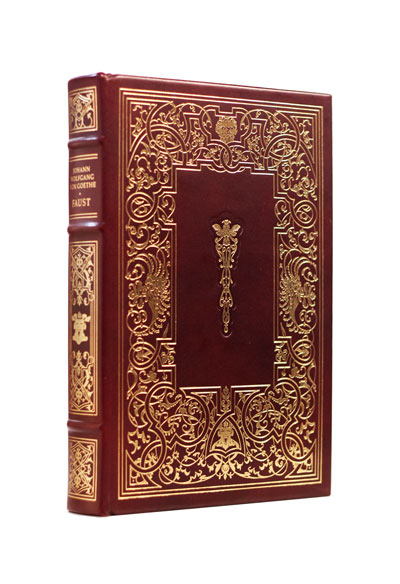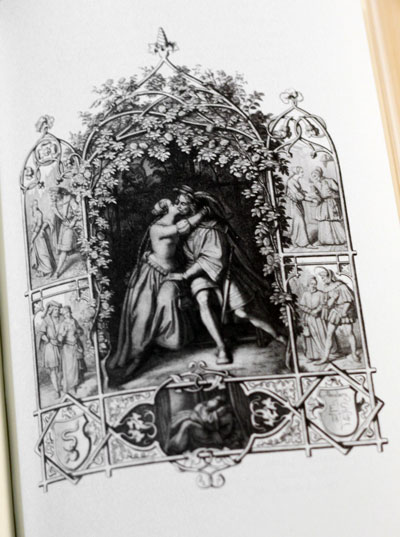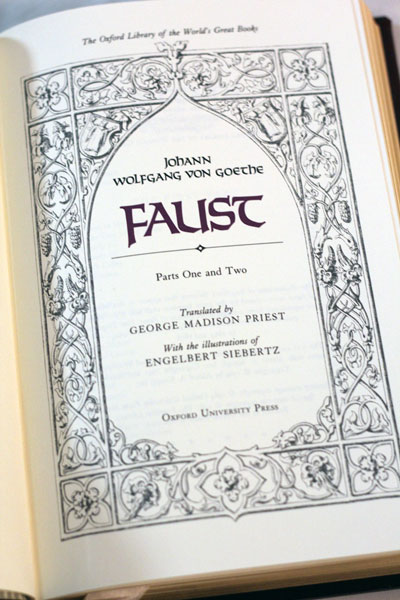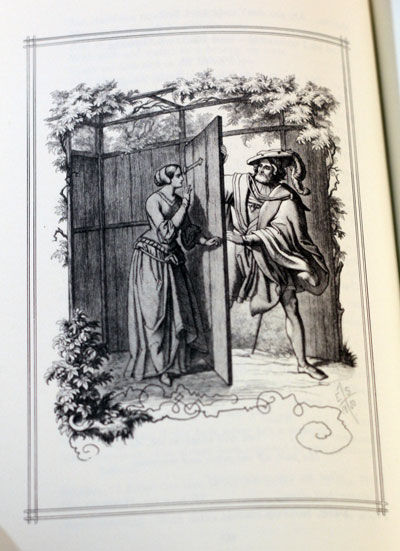Contains both Parts I and II (complete).
This book features:
- Full top-grade leather binding
- Genuine 22k gold gilt to all edges, front design, spine, and back
- Marbled endsheets
- Satin bookmark, sewn-in
- Hubbed spine with raised bands
- Smyth-sewn binding for durability
- Premium acid-neutral archival paper that will not yellow
FRANKLIN LIBRARY’S FINEST
The Franklin Library, the publishing division of The Franklin Mint, was of course, at one time, the nation’s largest publisher of great books in fine bindings. Founded in 1973, it ceased publishing in 2000. Its early editions ~ fully bound in genuine premium-grade, hand-cut leather, selected for quality of grain and texture ~ were designed and bound by The Sloves Organization, Ltd., an affiliate of the mint, whose bindery was one of the few in the world devoted exclusively to the crafting of fine leather books.
Printed from 1981 to 1985,* the Oxford/Franklin volumes are gorgeous ~ absolutely stunning in their production qualities. Oxford University Press, in fact, specially chose the publishing division of The Franklin Mint to design and produce its World’s Great Books series because of Franklin’s unsurpassed skill in achieving a premium-quality product: each Oxford book must also be ‘a wonder’ in the finest of bookbinding traditions and, if possible, exceed Franklin’s high standard. By that prestigious election, Franklin thus was also doubly honored and formally recognized for the awesome reputation it had achieved in the publishing world throughout the decade of the 1970s.
It is because of that ‘brief, shining moment’ in publication history that these fine classic Oxford/Franklin editions generally surpass anything else ever produced either before or after that time by any of today’s renowned publishing giants. Relatively few titles in the multi-edition Great Books series were given the fabulous full-leather treatment; most were quarter-bound volumes ~ very lovely indeed by the lights of their own publication merits ~ but still unable to boast the same ‘Rolls Royce’ elegance of their full-leather counterparts.
About Faust (from wikipedia):
Faust is Goethe’s most famous work and considered by many to be one of the greatest works of German literature.
Goethe completed a preliminary version of Part One in 1806. The 1808 publication was followed by the revised 1828–1829 edition, which was the last to be edited by Goethe himself. Prior to these appeared a partial printing in 1790 of Faust, a Fragment. The earliest forms of the work, known as the Urfaust, were developed between 1772 and 1775; however, the details of that development are no longer entirely clear.
Goethe finished writing Faust Part Two in 1832, the year of his death. In contrast to Faust Part One, the focus here is no longer on the soul of Faust, which has been sold to the devil, but rather on social phenomena such as psychology, history and politics, in addition to mystical and philosophical topics. The second part formed the principal occupation of Goethe’s last years and appeared only posthumously in 1832.
More about Faust on wikipedia.
About the Artist (from wikipedia):
Engelbert Seibertz (1813 – 1905) was a German portrait and history painter.
Engelbert Seibertz 1813 as the eldest son of Johann Suibert Seibertz born (1788-1871), the doyen of the Westphalian Regional History. His nephew was the eponymous Berlin church architect Engelbert Seibertz junior.
After a moderately successful school career Engelbert went as 17-year-old to Dusseldorf Art Academy, where the professors Lessing, Schadow, Cornelius and Hildebrandt were his teachers.
His first published work was a drawing of Bruchhauser stones, his image of Olsberger hut is now considered the oldest preserved industrial image of Westphalia.
Seibertz moved in 1832 to the Academy of Fine Arts in Munich and met Wilhelm von Kaulbach know, the court painter of King Ludwig I. During this period he produced 74 works of art, including frescoes in the Maximilianeum.
From 1835-1841 Seibertz lived again in Brilon and made sketches and illustrations to Goethe’s Faust. From 1841 to 1848 he worked in Prague. From 1850 to 1870 he lived in Munich again. For the Bavarian King Maximilian II, he created 300 works, including two monumental frescoes in the Maximilianeum, one of which has been preserved there. For the cathedral in Glasgow Seibertz designed the stained glass windows (but they were removed during the Second World War). In 1870, the painter returned to Arnsberg. From the last years of his work date back 140 pictures, mainly portraits of famous families Sauerland.







